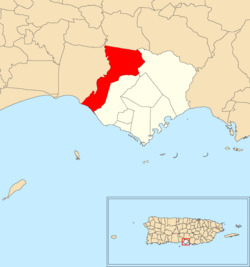Descalabrado
Descalabrado | |
|---|---|
Barrio | |
 House near where Central Cortada was | |
 Location of Descalabrado within the municipality of Santa Isabel shown in red | |
| Coordinates: 17°59′52″N 66°25′24″W / 17.997902°N 66.423405°W[1] | |
| Commonwealth | |
| Municipality | |
| Area | |
• Total | 10.11 sq mi (26.2 km2) |
| • Land | 7.19 sq mi (18.6 km2) |
| • Water | 2.92 sq mi (7.6 km2) |
| Elevation | 43 ft (13 m) |
| Population (2010) | |
• Total | 4,138 |
| • Density | 575.5/sq mi (222.2/km2) |
| Source: 2010 Census | |
| Time zone | UTC−4 (AST) |
Descalabrado is a barrio in the municipality of Santa Isabel, Puerto Rico. Its population in 2010 was 4,138.[3][4][5]
History
[edit]Central Cortada, also known as the Cortada Sugarcane Refinery, was a sugarcane plantation and refinery located in Descalabrado. The area where the refinery is located had been used for the growth and processing of sugarcane since the 18th century.[6]
Descalabrado was in Spain's gazetteers[7] until Puerto Rico was ceded by Spain in the aftermath of the Spanish–American War under the terms of the Treaty of Paris of 1898 and became an unincorporated territory of the United States. In 1899, the United States Department of War conducted a census of Puerto Rico finding that the combined population of Descalabrado and Boca Velázquez barrios was 1,083.[8]
In 1905, via an act of the US Congress, authorization was received to use water from the Descalabrado River to water the crops at the Central Cortada sugar plantation.[6]
| Census | Pop. | Note | %± |
|---|---|---|---|
| 1910 | 1,196 | — | |
| 1920 | 1,230 | 2.8% | |
| 1930 | 1,817 | 47.7% | |
| 1940 | 2,102 | 15.7% | |
| 1950 | 2,726 | 29.7% | |
| 1960 | 3,588 | 31.6% | |
| 1970 | 3,988 | 11.1% | |
| 1980 | 4,318 | 8.3% | |
| 1990 | 3,791 | −12.2% | |
| 2000 | 3,918 | 3.4% | |
| 2010 | 4,138 | 5.6% | |
| U.S. Decennial Census 1900 (N/A)[9] 1910-1930[10] 1930-1950[11] 1980-2000[12] 2010[13] | |||
Gallery
[edit]Scenes around Descalabrado:
- Ruins of the Central Cortada sugarcane mill
See also
[edit]References
[edit]- ^ a b "US Gazetteer 2019". US Census. US Government. Archived from the original on 2020-01-16. Retrieved 2020-07-09.
- ^ U.S. Geological Survey Geographic Names Information System: Descalabrado barrio
- ^ Picó, Rafael; Buitrago de Santiago, Zayda; Berrios, Hector H. Nueva geografía de Puerto Rico: física, económica, y social, por Rafael Picó. Con la colaboración de Zayda Buitrago de Santiago y Héctor H. Berrios. San Juan Editorial Universitaria, Universidad de Puerto Rico,1969.
- ^ Gwillim Law (20 May 2015). Administrative Subdivisions of Countries: A Comprehensive World Reference, 1900 through 1998. McFarland. p. 300. ISBN 978-1-4766-0447-3. Retrieved 25 December 2018.
- ^ Puerto Rico: 2010 Population and Housing Unit Counts.pdf (PDF). U.S. Dept. of Commerce, Economics and Statistics Administration, U.S. Census Bureau. 2010. Archived (PDF) from the original on 2017-02-20. Retrieved 2019-01-01.
- ^ a b "Central Cortada, el fin de la producción azucarera". Santa Isabel PR (in Spanish). February 21, 2009. Archived from the original on September 8, 2021. Retrieved October 1, 2021.
- ^ "Anuario del comercio, de la industria, de la magistratura y de la administración. 1881". Biblioteca Nacional de España (in Spanish). p. 1614. Retrieved 4 April 2023.
- ^ Joseph Prentiss Sanger; Henry Gannett; Walter Francis Willcox (1900). Informe sobre el censo de Puerto Rico, 1899, United States. War Dept. Porto Rico Census Office (in Spanish). Imprenta del gobierno. p. 165.
- ^ "Report of the Census of Porto Rico 1899". War Department Office Director Census of Porto Rico. Archived from the original on July 16, 2017. Retrieved September 21, 2017.
- ^ "Table 3-Population of Municipalities: 1930 1920 and 1910" (PDF). United States Census Bureau. Archived (PDF) from the original on August 17, 2017. Retrieved September 21, 2017.
- ^ "Table 4-Area and Population of Municipalities Urban and Rural: 1930 to 1950" (PDF). United States Census Bureau. Archived (PDF) from the original on August 30, 2015. Retrieved September 21, 2014.
- ^ "Table 2 Population and Housing Units: 1960 to 2000" (PDF). United States Census Bureau. Archived (PDF) from the original on July 24, 2017. Retrieved September 21, 2017.
- ^ Puerto Rico: 2010 Population and Housing Unit Counts.pdf (PDF). U.S. Dept. of Commerce Economics and Statistics Administration U.S. Census Bureau. 2010. Archived (PDF) from the original on 2017-02-20. Retrieved 2019-08-02.


 French
French Deutsch
Deutsch
